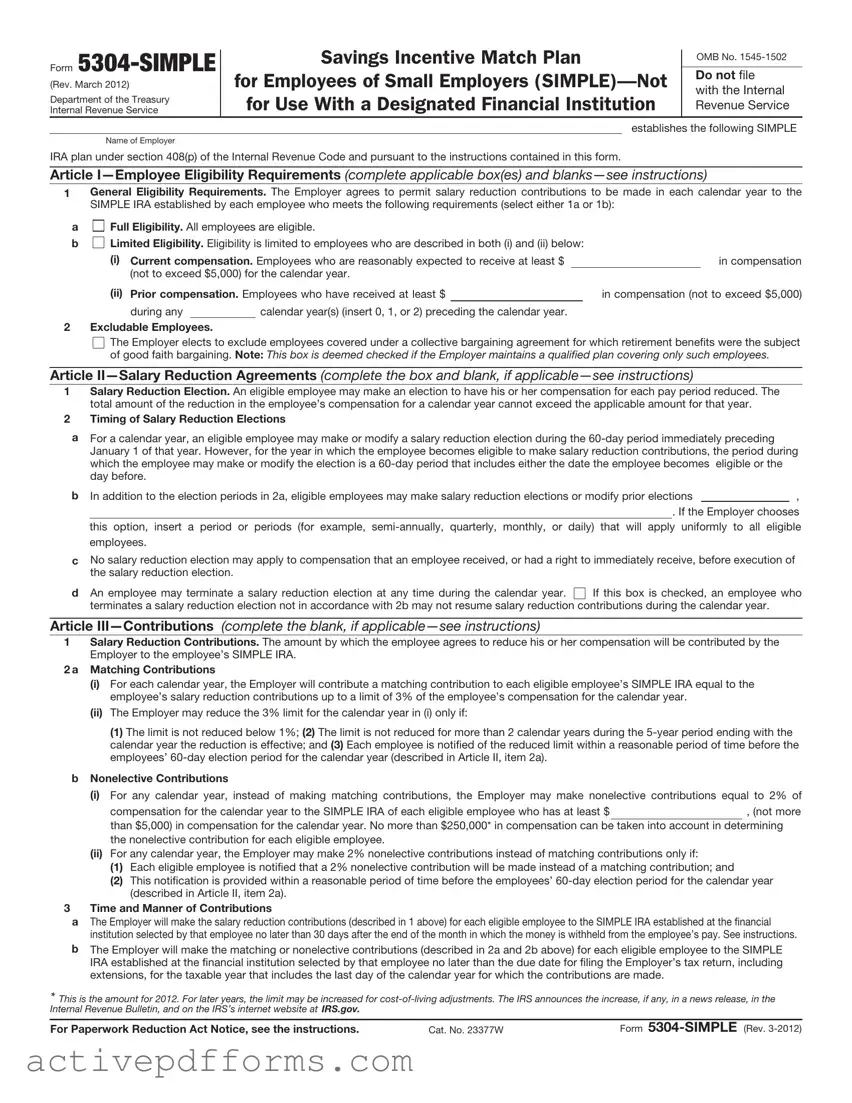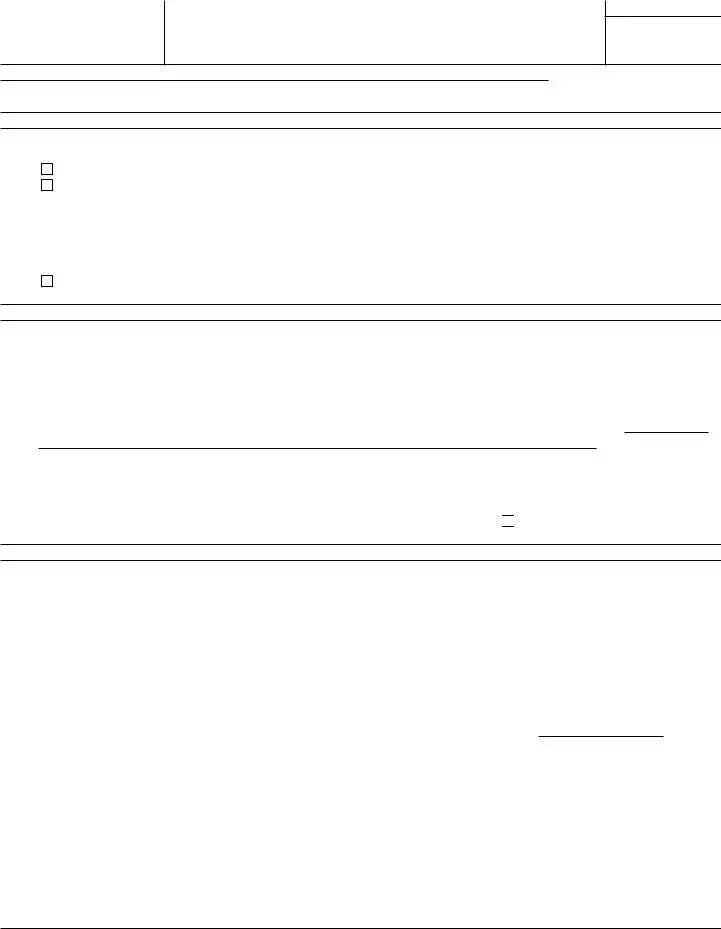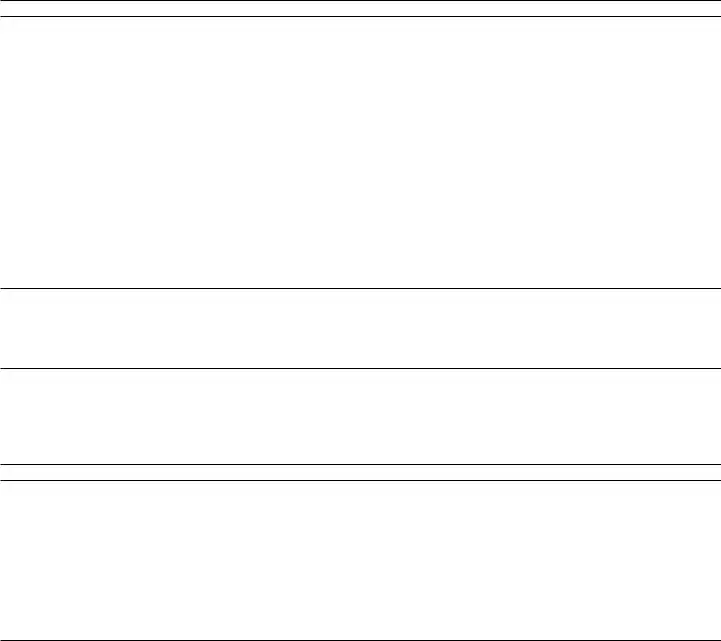establishes the following SIMPLE
Name of Employer
IRA plan under section 408(p) of the Internal Revenue Code and pursuant to the instructions contained in this form.
Article I—Employee Eligibility Requirements (complete applicable box(es) and blanks—see instructions)
1General Eligibility Requirements. The Employer agrees to permit salary reduction contributions to be made in each calendar year to the SIMPLE IRA established by each employee who meets the following requirements (select either 1a or 1b):
|
|
|
|
|
|
|
|
|
|
a |
Full Eligibility. All employees are eligible. |
|
|
b |
Limited Eligibility. Eligibility is limited to employees who are described in both (i) and (ii) below: |
|
|
|
(i) |
Current compensation. Employees who are reasonably expected to receive at least $ |
|
in compensation |
|
(ii) |
(not to exceed $5,000) for the calendar year. |
|
|
|
|
Prior compensation. Employees who have received at least $ |
|
|
in compensation (not to exceed $5,000) |
|
|
during any |
|
calendar year(s) (insert 0, 1, or 2) preceding the calendar year. |
|
|
2Excludable Employees.
The Employer elects to exclude employees covered under a collective bargaining agreement for which retirement benefits were the subject of good faith bargaining. Note: This box is deemed checked if the Employer maintains a qualified plan covering only such employees.
Article II—Salary Reduction Agreements (complete the box and blank, if applicable—see instructions)
1Salary Reduction Election. An eligible employee may make an election to have his or her compensation for each pay period reduced. The total amount of the reduction in the employee’s compensation for a calendar year cannot exceed the applicable amount for that year.
2Timing of Salary Reduction Elections
aFor a calendar year, an eligible employee may make or modify a salary reduction election during the 60-day period immediately preceding January 1 of that year. However, for the year in which the employee becomes eligible to make salary reduction contributions, the period during which the employee may make or modify the election is a 60-day period that includes either the date the employee becomes eligible or the day before.
b In addition to the election periods in 2a, eligible employees may make salary reduction elections or modify prior elections,
. If the Employer chooses this option, insert a period or periods (for example, semi-annually, quarterly, monthly, or daily) that will apply uniformly to all eligible employees.
cNo salary reduction election may apply to compensation that an employee received, or had a right to immediately receive, before execution of the salary reduction election.
dAn employee may terminate a salary reduction election at any time during the calendar year. 
 If this box is checked, an employee who terminates a salary reduction election not in accordance with 2b may not resume salary reduction contributions during the calendar year.
If this box is checked, an employee who terminates a salary reduction election not in accordance with 2b may not resume salary reduction contributions during the calendar year.
Article III—Contributions (complete the blank, if applicable—see instructions)
1Salary Reduction Contributions. The amount by which the employee agrees to reduce his or her compensation will be contributed by the Employer to the employee’s SIMPLE IRA.
2 a Matching Contributions
(i)For each calendar year, the Employer will contribute a matching contribution to each eligible employee’s SIMPLE IRA equal to the employee’s salary reduction contributions up to a limit of 3% of the employee’s compensation for the calendar year.
(ii)The Employer may reduce the 3% limit for the calendar year in (i) only if:
(1) The limit is not reduced below 1%; (2) The limit is not reduced for more than 2 calendar years during the 5-year period ending with the calendar year the reduction is effective; and (3) Each employee is notified of the reduced limit within a reasonable period of time before the employees’ 60-day election period for the calendar year (described in Article II, item 2a).
bNonelective Contributions
(i)For any calendar year, instead of making matching contributions, the Employer may make nonelective contributions equal to 2% of
compensation for the calendar year to the SIMPLE IRA of each eligible employee who has at least $, (not more
than $5,000) in compensation for the calendar year. No more than $250,000* in compensation can be taken into account in determining the nonelective contribution for each eligible employee.
(ii)For any calendar year, the Employer may make 2% nonelective contributions instead of matching contributions only if:
(1)Each eligible employee is notified that a 2% nonelective contribution will be made instead of a matching contribution; and
(2)This notification is provided within a reasonable period of time before the employees’ 60-day election period for the calendar year (described in Article II, item 2a).
3Time and Manner of Contributions
aThe Employer will make the salary reduction contributions (described in 1 above) for each eligible employee to the SIMPLE IRA established at the financial institution selected by that employee no later than 30 days after the end of the month in which the money is withheld from the employee’s pay. See instructions.
bThe Employer will make the matching or nonelective contributions (described in 2a and 2b above) for each eligible employee to the SIMPLE IRA established at the financial institution selected by that employee no later than the due date for filing the Employer’s tax return, including extensions, for the taxable year that includes the last day of the calendar year for which the contributions are made.
* This is the amount for 2012. For later years, the limit may be increased for cost-of-living adjustments. The IRS announces the increase, if any, in a news release, in the Internal Revenue Bulletin, and on the IRS’s internet website at IRS.gov.
For Paperwork Reduction Act Notice, see the instructions. |
Cat. No. 23377W |
Form 5304-SIMPLE (Rev. 3-2012) |



 If this box is checked, an employee who terminates a salary reduction election not in accordance with 2b may not resume salary reduction contributions during the calendar year.
If this box is checked, an employee who terminates a salary reduction election not in accordance with 2b may not resume salary reduction contributions during the calendar year.

